
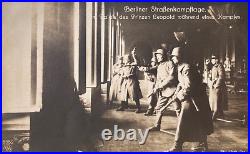
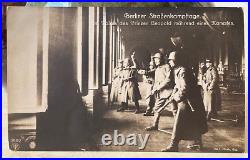
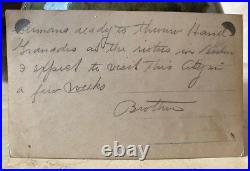

POST-WW1 GERMAN FREIKORPS BERLIN PRINCE LEOPOLD’S PALACE PHOTO POSTCARD RPPC c1919. PERIOD HAND ID’d ON THE REVERSE. Germans ready to throw Hand. Grenades as the rioters in Berlin. I expect to visit this City. In a few weeks. PERIOD CAPTIONED IN THE LOWER NEGATIVE. M palais des Prinzen Leopold während eines Kampfes. Berlin Street Fight Days. Prince Leopold’s palace during a fight. SHARP FOCUS WITH VERY GOOD CONTRAST. THIS IS NOT A REPRODUCTION OR A COPY.


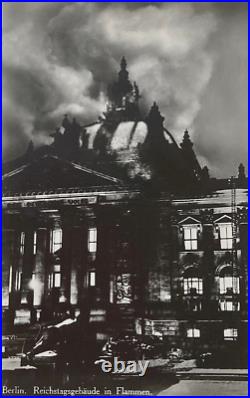
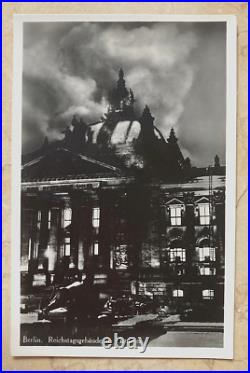
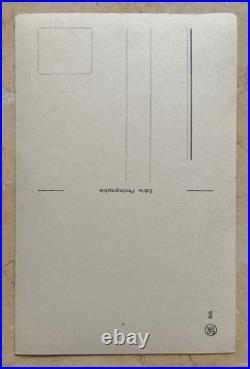
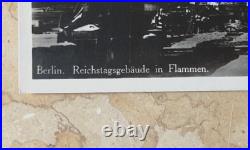

WW2 GERMAN WW2 GERMAN BERLIN REICHSTAG FIRE PHOTO POSTCARD RPPC. Was a false flag. Arson attack on the Reichstag building, home of the. German parliament in Berlin, on Monday, 27. February 1933, precisely 4 weeks after the WW2. German Leader was sworn in as Chancellor of Germany. Marinus van der Lubbe, a Dutch council communist. Was the culprit; the National Socialists attributed the fire to a. Group of Communist agitators, used it as a pretext to. Claim that Communists were plotting against the. German government, and induced President Paul. Von Hindenburg to issue the Reichstag Fire Decree. Suspending civil liberties, and pursue a ruthless. Confrontation with the Communists. The fire pivotal in the establishment of the National Socialist. CAPTIONED IN THE LOWER LEFT NEGATIVE. Reichstag building, in flames. PHOTO POST CARD MAKERS IMPRINT ON REVERSE. THIS IS NOT A REPRODUCTION OR A COPY.


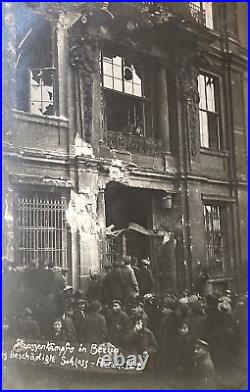
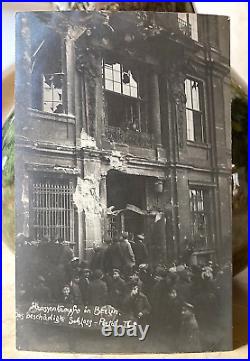
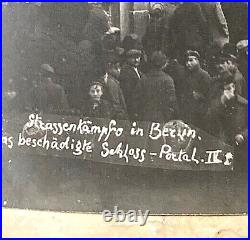
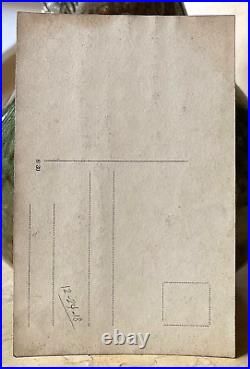


POST-WW1 GERMAN FREIKORPS CHRISTMAS CRISIS AT BERLIN PALACE PHOTO POSTCARD RPPC. POST-WW1 GERMAN FREIKORPS CHRISTMAS CRISIS AT BERLIN PALACE. POST-WW1 GERMAN FREIKORPS CHRISTMAS CRISIS AT BERLIN PALACE AT THE. RARE HAND CHRISTMAS EVE DATED PHOTO POSTCARD IMAGE OF IMPERIAL GERMAN SOLDIERS AND BERLINERS GATHERING AT THE CASTLE GATE #4 IN WHICH GREAT DAMAGE INFLICTED. PHOTO DOCUMENTED AS IT HAPPENED ON DECEMBER 24,1918. The 1918 Christmas crisis German: Weihnachtskämpfe or. Christmas battles’ or’Christmas rebellion’ was a brief battle between the socialist revolutionary Volksmarinedivision and regular German army units on 24 December 1918 during the German Revolution of 1918-19. It took place at the Berlin Palace, the main residence of the House of Hohenzollern. Around 67 people were killed, and the event marked the point at which the hitherto largely bloodless revolution turned more violent. The fighting was the immediate cause for the more radical members to leave the revolutionary government and led to resentment among the workers against the Social Democratic government of Friedrich Ebert. This set the scene for the much larger-scale violence of January 1919 known as the Spartacist uprising. Since the revolutionary sailors defeated the regular army force sent against them, the engagement was also an important episode in the rise of the right-wing Freikorps on which the government increasingly relied. PERIOD HAND OPAQUED CAPTION IN THE LOWER LEFT OF THE NEGATIVE. Das beschädigte Schloss – Portal. Street fighting in Berlin. The Damaged Castle – Portal. PERIOD HAND DATED ON THE REVERSE. VERY SHARP FOCUS WITH VERY GOOD CONTRAST. THIS IS NOT A REPRODUCTION OR A COPY.



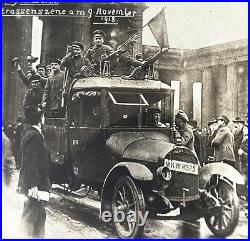
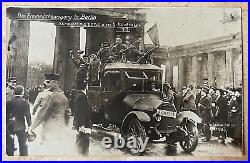
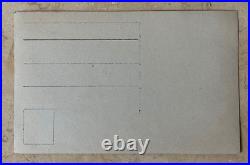
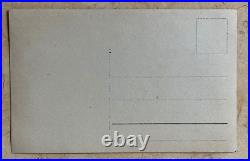
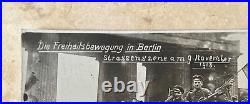

WWI GERMAN NOVEMBER REVOLUTION NOV 9, 1918 PHOTO POSTCARD RPPC. The November Revolution (November 9th) was a consequence of the military defeat of the German Empire in World War I. The revolution began in the military with sailors and spread to war-weary workers in Berlin and other German cities. The day was marked by demonstrations and the proclamation of the German republic. HAND OPAQUED ID IN THE UPPER LEFT NEGATIVE. Die Freiheitsbewegung in Berlin. The freedom movement in Berlin. Street scene in November 9. HAND OPAQUED PHOTOGRAPHER’S NAME IN THE LOWER RIGHT. VERY SHARP FOCUS WITH VERY GOOD CONTRAST. THIS IS NOT A REPRODUCTION OR A COPY.


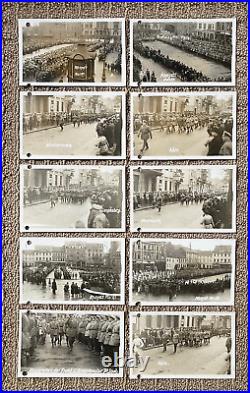
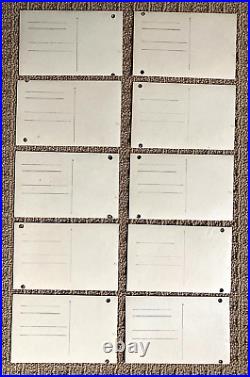
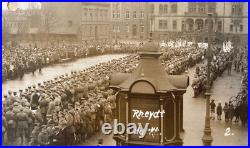
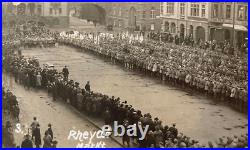
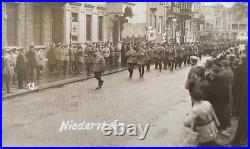
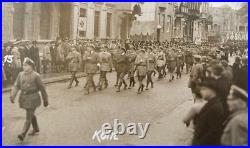
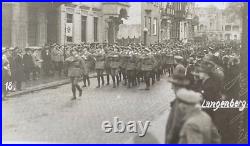
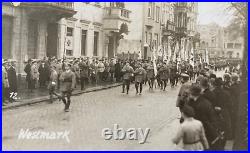
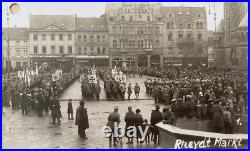
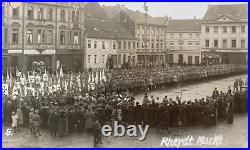
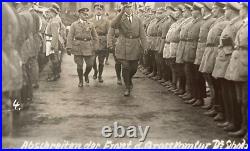
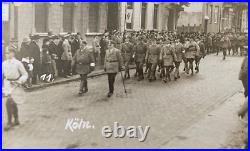
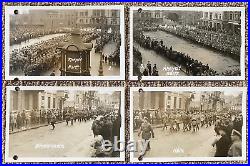
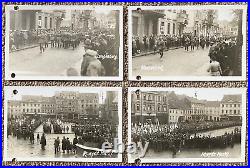


(10) POST WW1 STAHLHELM RALLY MARKTPLATZ RHEYDT MÖNCHENGLADBACH GERMANY RPPC PHOTO POSTCARDS c1923. (10) STAHLHELM RALLY MARKTPLATZ RHEYDT MÖNCHENGLADBACH GERMANY RPPC PHOTO POSTCARDS. (PARTIAL SET) OF RPPC’S ARE HAND CAPTIONED AND NUMBERED IN THE NEGATIVE. Abschreiten der Front d. Walking along the front d. Der Stahlhelm, Bund Der Frontsoldaten (German,’The Steel Helmet, League Of Front-Line Soldiers’), Known As Der Stahlhelm’The Steel Helmet’, Was A German WW1 Veteran’s Organization Existing From 1918 To 1935. It Was Part Of The ” Black Reichswehr ” And In The Later Days Of The German Weimar Republic Operated As A Paramilitary And Placed At Political Party Gatherings As Armed Security Guards. CONDITIONS ARE EXTREMELY FINE WITH PERIOD FILE HOLES ON THE FRONT LEFT OF EACH. SHARP FOCUS WITH VERY GOOD CONTRAST ON EACH. THESE ARE NOT REPRODUCTIONS OR COPIES.


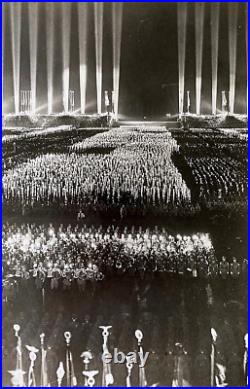
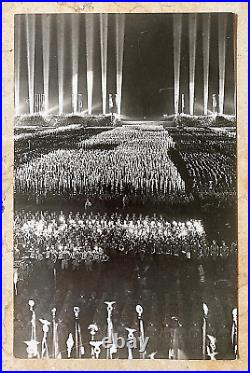
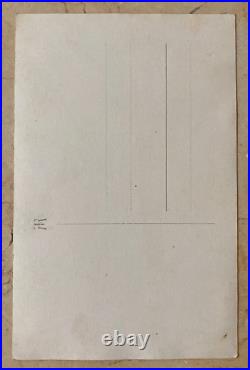

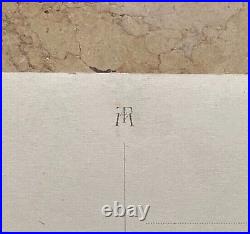

PRE-WW2 GERMAN NUREMBERG 1936 RALLY CATHEDRAL of LIGHT – PHOTO POSTCARD RPPC. AT THE LUITPOLD ARENA NUREMBERG GERMANY DURING THE MAIN EVENING CALLED. CATHEDRAL OF LIGHT IN 1936. PHOTOGRAPHER’S LOGO ON THE REVERSE. THIS MASSIVE RALLY AT THE. LUITPOLD ARENA IN NURMBERG GERMANY WAS HELD SEPTEMBER 8-14,1936. The single most dramatic moment of the NS rallies. Was not a military parade or a political speech but the Cathedral of Light… SHARP FOCUS AND VERY GOOD CONTRAST. THIS IS NOT A REPRODUCTION OR A COPY.


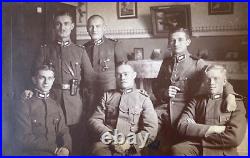
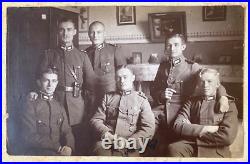
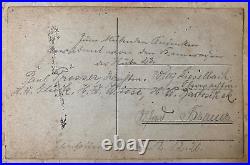
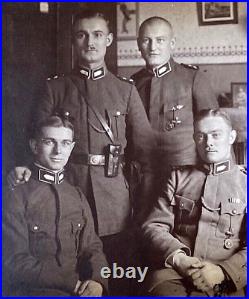
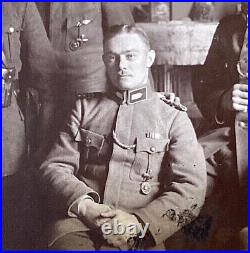
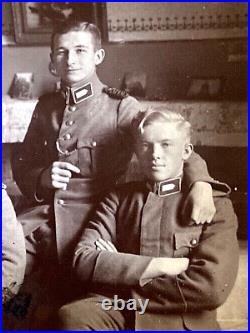

POST-WW1 GERMAN GARDE KAVALLERIE SCHUTZEN DIVISION 1920 ID’d PHOTO POSTCARD RPPC. POST-WW1 GERMAN GARDE, KAVALLERIE, SCHUTZEN, DIVISION 1920 G. SIX POST-WW1 GERMAN ” G ARDE, K AVALLERIE, S CHUTZEN, D IVISION ” G. OFFICERS FROM CHARLOTTENBURG (BERLIN) POSE IN THEIR REICHSWEHR UNIFORMS WITH VARIOUS BADGES. Ie; BALTIC CROSSES, WW1 WOUND BADGES, MARKSMANSHIP LANYARDS, IRON CROSS RIBBON AND RIBBON BAR. EACH SITTER IS PERIOD ID’d ON THE REVERSE. IN OLD GERMAN SCRIPT AND DATED. VERY SHARP FOCUS WITH VERY GOOD CONTRAST. THIS IS NOT A REPRODUCTION OR A COPY.


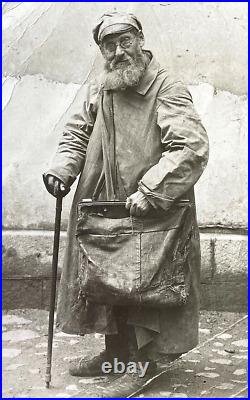


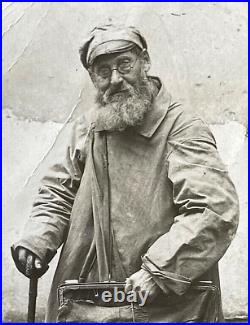
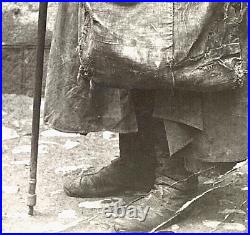
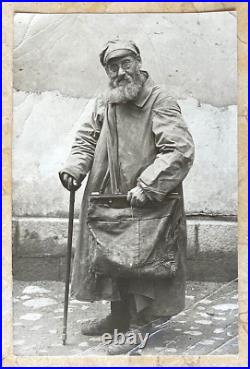
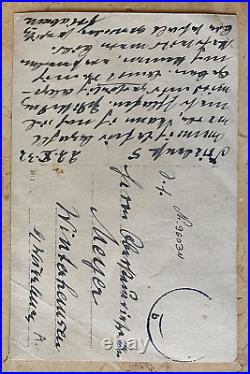
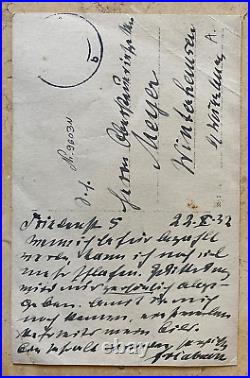

POST-WW1 GERMAN MAN DURING “THE GREAT DEPRESSION” 1932 PHOTO POSTCARD RPPC. POST-WW1 GERMAN CITIZEN DURING THE ” GREAT DEPRESSION ” IN LATE 1932 STOPS ON THE STREET IN FRANKFURT HOPING FOR A HANDOUT. In October of 1929, a worldwide depression began. A depression is a severe economic downturn that forced businesses to decrease production and lay off workers. Germany felt the effects of the depression almost immediately. By 1932, 6 million Germans were unemployed in a nation of about 60 million people, lighting the way. Towards World War 2. PERIOD HAND WRITTEN UNTRANSLATED CONTENT WITH LOCATION AND DATE IN OLD GERMAN SCRIPT. FRANKFURT OCTOBER 22,1932. POSTAL REGISTRATION NUMBERED #9603N. VERY SHARP FOCUS WITH VERY GOOD CONTRAST. THIS IS NOT A REPRODUCTION OR A COPY.


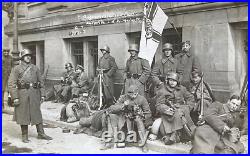
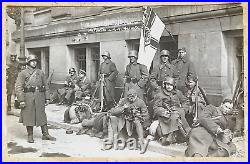

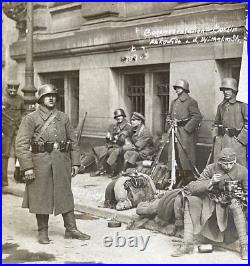
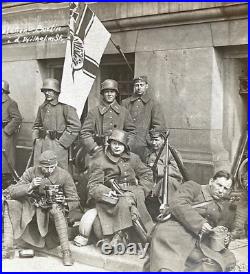
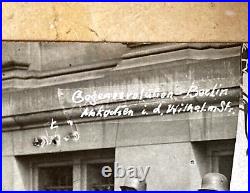
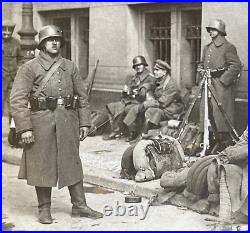
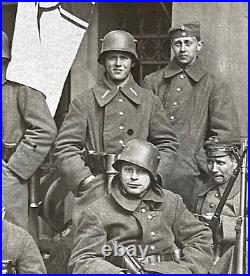

POST-WW1 GERMAN KAPP PUTSCH FREIKORPS in BERLIN 1920 PHOTO POSTCARD RPPC. POST-WW1 GERMAN KAPP PUTSCH FREIKORPS in BERLIN 1920. FULLY ARMED POST-WW1 GERMAN KAPP PUTSCH FREIKORPS MEMBERS OF THE MARINE BRIGADE EHRHARDT ARE SEEN WITH THE IMPERIAL NAVY FLAG ON THE STREETS OF BERLIN DURING THE KAPP-PUTSCH in BERLIN MARCH 1920. Was an attempted coup against the German national government in Berlin on 13 March 1920 that lasted 5 days. Also known as the. Was a Freikorps unit of the early Weimar Republic. It was formed on 17 February 1919 as the Second Marine Brigade from sailors (Matrosen) of the former Imperial German Navy under the leadership of Hermann Ehrhardt. The Brigade was used primarily in the suppression of the Bavarian Soviet Republic and the First Silesian Uprising, both in the first half of 1919. In March 1920, faced with its imminent disbanding by orders of the government in Berlin, the Marine Brigade was one of the main supporters of the Kapp Putsch that tried to overthrow the Weimar Republic. TITLED IN THE LOWER NEGATIVE. VERY SHARP FOCUS WITH VERY GOOD CONTRAST. THIS IS NOT A REPRODUCTION OR A COPY.


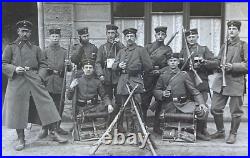
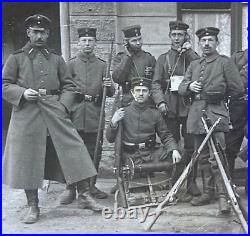
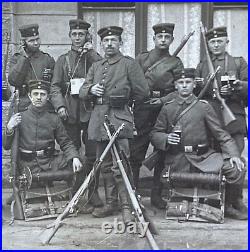
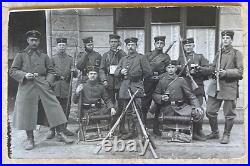
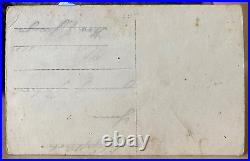


POST-WW1 GERMAN KAPP PUTSCH FREIKORPS TELEPHONES BERLIN 1920 PHOTO POSTCARD RPPC. POST-WW1 GERMAN KAPP PUTSCH FREIKORPS w/ TELEPHONES BERLIN 1920 PHOTO POSTCARD RPPC. ARMED POST-WW1 GERMAN KAPP PUTSCH FREIKORPS MEMBERS OF THE MARINE BRIGADE EHRHARDT ARE SEEN WITH TELEPHONE CABLE LAYER BACKPACKS, TELEPHONE HANDSETS AND A CABLE WIRE POLE HAND TOOL ON THE STREETS OF BERLIN DURING THE KAPP-PUTSCH in BERLIN MARCH 1919. PARTIAL TRANSLATED PERIOD HAND ID’D ON THE REVERSE IN OLD GERMAN SCRIPT. – – isangn. Was an attempted coup against the German national government in Berlin on 13 March 1920 that lasted 5 days. Also known as the. Was a Freikorps unit of the early Weimar Republic. It was formed on 17 February 1919 as the Second Marine Brigade from sailors (Matrosen) of the former Imperial German Navy under the leadership of Hermann Ehrhardt. The Brigade was used primarily in the suppression of the Bavarian Soviet Republic and the First Silesian Uprising, both in the first half of 1919. In March 1920, faced with its imminent disbanding by orders of the government in Berlin, the Marine Brigade was one of the main supporters of the Kapp Putsch that tried to overthrow the Weimar Republic. VERY SHARP FOCUS WITH VERY GOOD CONTRAST. THIS IS NOT A REPRODUCTION OR A COPY.













































































